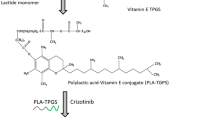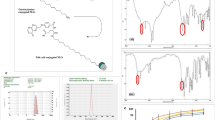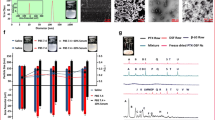Abstract
The resistance of cancer cells to chemotherapy has presented a formidable challenge. The current research aims at evaluating whether silencing of the cisplatin efflux promoter gene ABCC3 using siRNA co-loaded with the drug in a nanocarrier improves its efficacy in non-small cell lung cancer (NSCLC). Hybrid nanocarriers (HNCs) comprising lipids and poly(lactic acid-polyethylene glycol) di-block copolymer (PEG-PLA) were prepared for achieving the simultaneous delivery of cisplatin caprylate and ABCC3-siRNA to the cancer cells. PEGylation of the formulated HNCs was carried out using post-insertion technique for imparting long circulation characteristics to the carrier. The optimized formulation exhibited an entrapment efficiency of 71.9 ± 2.2% and 95.83 ± 0.39% for cisplatin caprylate and siRNA respectively. Further, the HNC was found to have hydrodynamic diameter of 153.2 ± 1.76 nm and + 25.39 ± 0.49 mV zeta potential. Morphological evaluation using cryo transmission electron microscopy confirmed the presence of lipid bilayer surrounding the polymeric core in HNCs. The in vitro cellular uptake studies showed improved uptake, while cell viability studies of the co-loaded formulation in A549 cell-line indicated significantly improved cytotoxic potential when compared with drug solution and drug-loaded HNCs; cell cycle analysis indicated increased percentage of cell arrest in G2-M phase compared with drug-loaded HNCs. Further, the gene knock-down study showed that silencing of ABCC3 mRNA might be improved in vitro efficacy of the formulation. The optimized cisplatin and ABCC3 siRNA co-loaded formulation presented significantly increased half-life and tumour regression in A549 xenograft model in BALB/c nude mice. In conclusion, siRNA co-loaded formulation presented reduced drug resistance and increased efficacy, which might be promising for the current cisplatin-based treatments in NSCLC.
Graphical abstract










Similar content being viewed by others
Abbreviations
- HNCs:
-
Hybrid nanocarriers
- CCL-HNCs:
-
Cisplatin caprylate-loaded HNCs
- CCL-p-HNCs:
-
PEGylated CCL-HNCs
- rCCL-p-HNCs:
-
SiRNA complexed CCL-p-HNCs
- ncr:
-
FITC-labelled negative control siRNA (FITC-NC-siRNA)
- ncrL2K:
-
FITC-labelled negative control siRNA complexed with lipofectamine 2000
- ncrCCL-p-HNCs:
-
FITC-labelled negative control siRNA complexed CCL-p-HNCs
References
Torre LA, Siegel RL, Jemal A. Lung cancer statistics. Lung cancer and personalized medicine. Springer; 2016. p. 1–19.
Stewart DJ. Lung cancer: prevention, management, and emerging therapies. Springer Science & Business Media; 2010.
Saraswathy M, Gong S. Different strategies to overcome multidrug resistance in cancer. Biotechnol Adv. 2013;31(8):1397–407.
Szakács G, Paterson JK, Ludwig JA, Booth-Genthe C, Gottesman MM. Targeting multidrug resistance in cancer. Nat Rev Drug Discovery. 2006;5(3):219–34.
Chen Ba, Pp Mao J, Cheng FG, Xia Gh, Xu Wl, et al. Reversal of multidrug resistance by magnetic Fe3O4 nanoparticle copolymerizating daunorubicin and MDR1 shRNA expression vector in leukemia cells. Int J Nanomed. 2010;5:437.
Zhao Y, Lu H, Yan A, Yang Y, Meng Q, Sun L, et al. ABCC3 as a marker for multidrug resistance in non-small cell lung cancer. Scientific reports. 2013;3:3120.
Creixell M, Peppas NA. Co-delivery of siRNA and therapeutic agents using nanocarriers to overcome cancer resistance. Nano today. 2012;7(4):367–79.
Misra A. THERAPEUTIC siRNA : DELIVERYCHALLENGES.
Misra A. Challenges in delivery of therapeutic genomics and proteomics. Elsevier; 2010.
Gao Z, Zhang L, Sun Y. Nanotechnology applied to overcome tumor drug resistance. J Control Release. 2012;162(1):45–55.
Arora S, Rajwade JM, Paknikar KM. Nanotoxicology and in vitro studies: the need of the hour. Toxicol Appl Pharmacol. 2012;258(2):151–65.
Blanco E, Shen H, Ferrari M. Nanoparticle rational design implementation for overcoming delivery barriers. Nat Biotechnol. 2015;33:941–51.
Jia F, Liu X, Li L, Mallapragada S, Narasimhan B, Wang Q. Multifunctional nanoparticles for targeted delivery of immune activating and cancer therapeutic agents. J Control Release. 2013;172(3):1020–34.
Schiffelers RM, Ansari A, Xu J, Zhou Q, Tang Q, Storm G et al. Cancer siRNA therapy by tumor selective delivery with ligand-targeted sterically stabilized nanoparticle. Nucleic acids research. 2004;32(19):e149-e.
Saad M, Garbuzenko OB, Minko T. Co-delivery of siRNA and an anticancer drug for treatment of multidrug-resistant cancer. Nanomedicine. 2008;3(6):761–76. https://doi.org/10.2217/17435889.3.6.761.
Vhora I, Khatri N, Desai J, Thakkar HP. Caprylate-conjugated cisplatin for the development of novel liposomal formulation. AAPS PharmSciTech. 2014;15(4):845–57.
Zhao P, Wang H, Yu M, Liao Z, Wang X, Zhang F, et al. Paclitaxel loaded folic acid targeted nanoparticles of mixed lipid-shell and polymer-core: in vitro and in vivo evaluation. Eur J Pharm Biopharm. 2012;81(2):248–56.
Mandal B, Bhattacharjee H, Mittal N, Sah H, Balabathula P, Thoma LA, et al. Core–shell-type lipid–polymer hybrid nanoparticles as a drug delivery platform. Nanomed Nanotechnol Biol Med. 2013;9(4):474–91.
Troutier A-L, Delair T, Pichot C, Ladavière C. Physicochemical and interfacial investigation of lipid/polymer particle assemblies. Langmuir. 2005;21(4):1305–13.
Vhora I, Lalani R, Bhatt P, Patil S, Patel H, Patel V, et al. Colloidally stable small unilamellar stearyl amine lipoplexes for effective bmp-9 gene delivery to stem cells for osteogenic differentiation. AAPS PharmSciTech. 2018;19(8):3550–60.
Vhora I, Lalani R, Bhatt P, Patil S, Misra A. Lipid-nucleic acid nanoparticles of novel ionizable lipids for systemic BMP-9 gene delivery to bone-marrow mesenchymal stem cells for osteoinduction. Int J Pharm. 2019;563:324–36.
Patil S, Bhatt P, Lalani R, Amrutiya J, Vhora I, Kolte A, et al. Low molecular weight chitosan–protamine conjugate for siRNA delivery with enhanced stability and transfection efficiency. RSC advances. 2016;6(112):110951–63.
Garcia-Diez R, Gollwitzer C, Krumrey M, Varga Z. Size determination of a liposomal drug by small-angle X-ray scattering using continuous contrast variation. Langmuir. 2016;32(3):772–8.
Chono S, Li S-D, Conwell CC, Huang L. An efficient and low immunostimulatory nanoparticle formulation for systemic siRNA delivery to the tumor. J Control Release. 2008;131(1):64–9.
Patil S, Lalani R, Bhatt P, Vhora I, Patel V, Patel H, et al. Hydroxyethyl substituted linear polyethylenimine for safe and efficient delivery of siRNA therapeutics. RSC advances. 2018;8(62):35461–73.
Bhatt P, Lalani R, Vhora I, Patil S, Amrutiya J, Misra A, et al. Liposomes encapsulating native and cyclodextrin enclosed paclitaxel: Enhanced loading efficiency and its pharmacokinetic evaluation. Int J Pharm. 2018;536(1):95–107.
Bhatt P, Narvekar P, Lalani R, Chougule MB, Pathak Y, Sutariya V. An in vitro assessment of thermo-reversible gel formulation containing sunitinib nanoparticles for neovascular age-related macular degeneration. AAPS PharmSciTech. 2019;20(7):281.
Saloustros E, Mavroudis D, Georgoulias V. Paclitaxel and docetaxel in the treatment of breast cancer. Expert Opin Pharmacother. 2008;9(15):2603–16.
Zuidam NJ, Gouw HME, Barenholz Y, Crommelin DJ. Physical (in) stability of liposomes upon chemical hydrolysis: the role of lysophospholipids and fatty acids. Biochimica et Biophysica Acta (BBA)-Biomembranes. 1995;1240(1):101–10.
Maecker HT, Trotter J. Flow cytometry controls, instrument setup, and the determination of positivity. Cytometry Part A: the journal of the International Society for Analytical Cytology. 2006;69(9):1037–42.
Bepler G, Kusmartseva I, Sharma S, Gautam A, Cantor A, Sharma A, et al. RRM1 modulated in vitro and in vivo efficacy of gemcitabine and platinum in non-small-cell lung cancer. J Clin Oncol. 2006;24(29):4731–7.
Morgan KM, Riedlinger GM, Rosenfeld J, Ganesan S, Pine SR. Patient-derived xenograft models of non-small cell lung cancer and their potential utility in personalized medicine. Frontiers in oncology. 2017;7:2.
van ErpLakerveld EAAJ, Mulder H, Luytjes W, Ferwerda G, van Kasteren PB. Pathogenesis of respiratory syncytial virus infection in BALB/c mice differs between intratracheal and intranasal inoculation. Viruses. 2019;11(6):508.
Nair AB, Jacob S. A simple practice guide for dose conversion between animals and human. Journal of basic and clinical pharmacy. 2016;7(2):27.
Zhao X, Li F, Li Y, Wang H, Ren H, Chen J, et al. Co-delivery of HIF1α siRNA and gemcitabine via biocompatible lipid-polymer hybrid nanoparticles for effective treatment of pancreatic cancer. Biomaterials. 2015;46:13–25.
Bardoliwala D, Patel V, Javia A, Ghosh S, Patel A, Misra A. Nanocarriers in effective pulmonary delivery of siRNA: current approaches and challenges. Therapeutic delivery. 2019;10(5):311–32.
Chan JM, Zhang L, Yuet KP, Liao G, Rhee J-W, Langer R, et al. PLGA–lecithin–PEG core–shell nanoparticles for controlled drug delivery. Biomaterials. 2009;30(8):1627–34.
Mare R, Paolino D, Celia C, Molinaro R, Fresta M, Cosco D. Post-insertion parameters of PEG-derivatives in phosphocholine-liposomes. Int J Pharm. 2018;552(1–2):414–21.
Wang Q, Alshaker H, Böhler T, Srivats S, Chao Y, Cooper C, et al. Core shell lipid-polymer hybrid nanoparticles with combined docetaxel and molecular targeted therapy for the treatment of metastatic prostate cancer. Scientific reports. 2017;7(1):1–8.
Štarha P, Trávníček Z, Popa I, Dvořák Z. Synthesis, characterization and in vitro antitumor activity of platinum (II) oxalato complexes involving 7-azaindole derivatives as coligands. Molecules. 2014;19(8):10832–44.
Khatri N, Rathi M, Baradia D, Misra A. cRGD grafted siRNA nano-constructs for chemosensitization of gemcitabine hydrochloride in lung cancer treatment. Pharm Res. 2015;32(3):806–18.
Rabanel J-M, Hildgen P, Banquy X. Assessment of PEG on polymeric particles surface, a key step in drug carrier translation. J Control Release. 2014;185:71–87.
Nakamura K, Yamashita K, Itoh Y, Yoshino K, Nozawa S, Kasukawa H. Comparative studies of polyethylene glycol-modified liposomes prepared using different PEG-modification methods. Biochimica et Biophysica Acta (BBA)-Biomembranes. 2012;1818(11):2801–7.
Zhang L, Hu Y, Jiang X, Yang C, Lu W, Yang YH. Camptothecin derivative-loaded poly (caprolactone-co-lactide)-b-PEG-b-poly (caprolactone-co-lactide) nanoparticles and their biodistribution in mice. J Control Release. 2004;96(1):135–48.
Li X, Li R, Qian X, Ding Y, Tu Y, Guo R, et al. Superior antitumor efficiency of cisplatin-loaded nanoparticles by intratumoral delivery with decreased tumor metabolism rate. Eur J Pharm Biopharm. 2008;70(3):726–34.
Płaczek M, Kosela M. Microscopic methods in analysis of submicron phospholipid dispersions. Acta Pharmaceutica. 2016;66(1):1–22.
Ruozi B, Belletti D, Tombesi A, Tosi G, Bondioli L, Forni F, et al. AFM, ESEM, TEM, and CLSM in liposomal characterization: a comparative study. Int J Nanomed. 2011;6:557.
Ren F, Chen R, Wang Y, Sun Y, Jiang Y, Li G. Paclitaxel-loaded poly (n-butylcyanoacrylate) nanoparticle delivery system to overcome multidrug resistance in ovarian cancer. Pharm Res. 2011;28(4):897–906.
Nishiyama N, Okazaki S, Cabral H, Miyamoto M, Kato Y, Sugiyama Y, et al. Novel cisplatin-incorporated polymeric micelles can eradicate solid tumors in mice. Can Res. 2003;63(24):8977–83.
Gryparis EC, Hatziapostolou M, Papadimitriou E, Avgoustakis K. Anticancer activity of cisplatin-loaded PLGA-mPEG nanoparticles on LNCaP prostate cancer cells. Eur J Pharm Biopharm. 2007;67(1):1–8.
Xu P, Van KirkLi EAS, Murdoch WJ, Ren J, Hussain MD, et al. Highly stable core-surface-crosslinked nanoparticles as cisplatin carriers for cancer chemotherapy. Colloids Surf, B. 2006;48(1):50–7.
Khatri N, Rathi MN, Baradia D, Trehan S, Misra A. In vivo delivery aspects of miRNA, shRNA and siRNA. Critical Reviews™ in Therapeutic Drug Carrier Systems. 2012;29(6).
Qu M-H, Zeng R-F, Fang S, Dai Q-S, Li H-P, Long J-T. Liposome-based co-delivery of siRNA and docetaxel for the synergistic treatment of lung cancer. Int J Pharm. 2014;474(1–2):112–22.
Fröhlich E. The role of surface charge in cellular uptake and cytotoxicity of medical nanoparticles. Int J Nanomed. 2012;7:5577.
Prabhakar U, Maeda H, Jain RK, Sevick-Muraca EM, Zamboni W, Farokhzad OC et al. Challenges and key considerations of the enhanced permeability and retention effect for nanomedicine drug delivery in oncology. AACR; 2013.
Sadat SM, Jahan ST, Haddadi A. Effects of size and surface charge of polymeric nanoparticles on in vitro and in vivo applications. Journal of Biomaterials and Nanobiotechnology. 2016;7(02):91.
Guo S, Huang L. Nanoparticles escaping RES and endosome: challenges for siRNA delivery for cancer therapy. Journal of Nanomaterials. 2011;2011:11.
Acknowledgements
The authors are thankful to Prof. Paola Luciani (Former Professor of Phospholipids in drug delivery at Friedrich schiller university of Jena) for providing laboratory and technical support in completion of current work and Dr Bhavin Vyas (Head, Department of Pharmacology, Maliba Pharmacy College, Uka Tarsadia University, Bardoli) for providing facilities for animal studies. The authors acknowledge support from Indian institute of technology (IIT), Gandhinagar for AFM studies, Prof Ashish Ganguly of Institute of microbial technology (IMTech), Chandigarh for SAXS studies, Sun Pharmaceutical advanced research centre (SPARC), Vadodara for Cryo-TEM studies.
Funding
This work was supported by Department of Science and Technology (DST), Government of India and German academic exchange service (DAAD), a collaborative project between Faculty of Pharmacy, The Maharaja Sayajirao University of Baroda and Friedrich schiller university of Jena, Germany. The contingency grant was provided by University grant commission (UGC), Government of India.
Author information
Authors and Affiliations
Corresponding author
Ethics declarations
Conflict of interest
The authors declare that they have no competing interests.
Additional information
Publisher’s Note
Springer Nature remains neutral with regard to jurisdictional claims in published maps and institutional affiliations.
Rights and permissions
About this article
Cite this article
Patel, V., Lalani, R., Vhora, I. et al. Co-delivery of cisplatin and siRNA through hybrid nanocarrier platform for masking resistance to chemotherapy in lung cancer. Drug Deliv. and Transl. Res. 11, 2052–2071 (2021). https://doi.org/10.1007/s13346-020-00867-5
Accepted:
Published:
Issue Date:
DOI: https://doi.org/10.1007/s13346-020-00867-5




